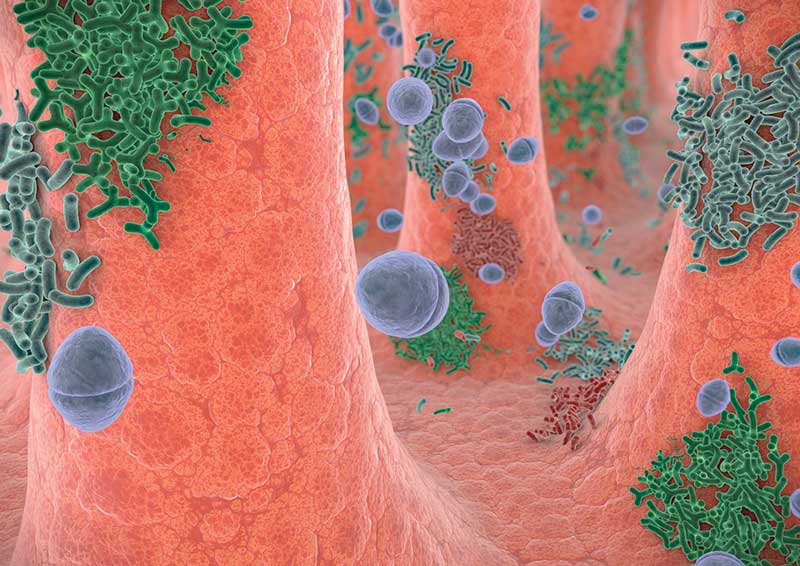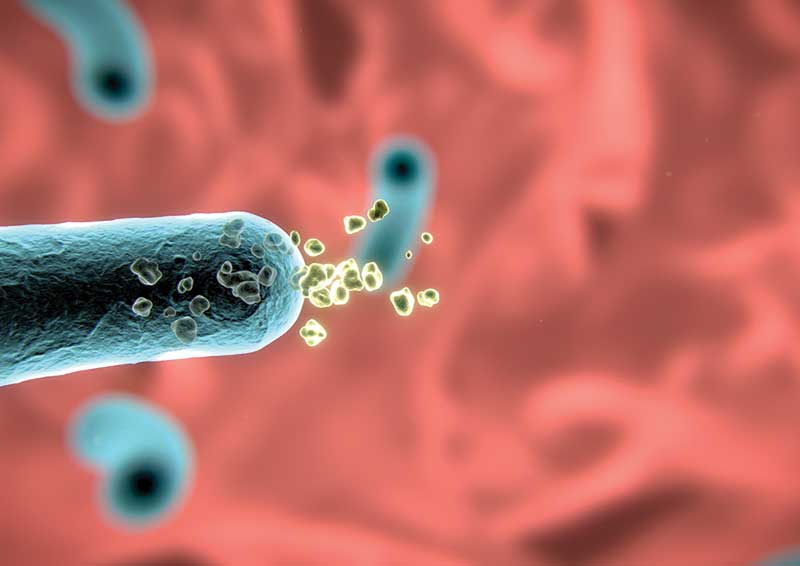
The gastrointestinal (GI) tract is known as the body system responsible for food digestion and nutrient absorption. However, the gut does much more. It is also home to the GI microbiome—a complex microbial ecosystem comprising trillions of microorganisms that play a significant role in the overall health of both humans and pets. Further, the gut contains 70 percent of the body’s immune cells, which protect against potentially harmful organisms (pathogens) and foreign substances (antigens).1
The role of the GI microbiome
Studies have shown the GI microbiome may exert significant effects on multiple body systems. In addition to its digestive function, the gut works as a kind of sensory organ for the immune system, given that whatever enters the mouth is exposed to the gut. Metabolites generated by digestion travel to other parts of the body through the bloodstream, with the potential to activate or suppress inflammatory processes.
The GI microbiome affects the health of dogs and cats in a variety of ways by influencing energy balance, metabolism, immune response, vitamin and mineral synthesis, endocrine signaling, gut function, and neurobehavioral development through the gut-brain axis.2
Given the microbiota in the gut help support overall health, maintaining a balance between beneficial and potentially pathogenic bacteria is important.
A disruption in microbial balance—known as dysbiosis—can be triggered by multiple factors, including antibiotic use, stress, age, illness, diet change, and weaning. Dysbiosis is also associated with a variety of health conditions, ranging from irritable bowel disease (IBD), obesity, and cardiovascular disease to immune-mediated conditions and neurodevelopmental conditions.2
However, while disruptions to the homeostasis of the microbiome can contribute to disease, dysbiosis by itself does not always cause it. The key is the function of the GI tract. For example, if an animal has antibiotic-induced dysbiosis, but the GI tract is otherwise functioning normally, the intestine’s epithelial barrier can usually withstand this short-term disruption. An animal with a chronic GI disease, accompanied by inflammatory changes in the epithelium and a compromised mucus layer, is a different case. In this situation, if there is also dysbiosis, a complex, long-term condition may develop that requires multiple therapeutic interventions to manage.
Nutritional tools
A balanced gut microbiome is critical to canine and feline health. Correcting GI dysbiosis requires a multipronged approach, which could include the following nutritional interventions:
Diet
Diet should be considered the primary strategy when managing patients with dysbiosis. An estimated 50 to 65 percent of dogs with chronic inflammatory enteropathies respond positively to dietary changes.3 For canine patients with small intestinal or mixed bowel diarrhea, starting with a highly digestible diet that allows nutrients to be readily absorbed, followed by a reevaluation of the dog’s clinical signs 10 to 14 days later can be recommended.
If no improvement is noted, a diet trial utilizing a hydrolyzed, novel protein, or amino acid-based diet may be indicated. Dogs with large bowel diarrhea and some with mixed bowel diarrhea may be more responsive to a high-fiber diet. If improvement in clinical signs is not achieved with diet alone, an immunosuppressive medication or an antibiotic can be considered.
Picking a probioticNot all probiotics are equal and interchangeable. Veterinary health care teams play an important role in educating clients and guiding their probiotic supplement choices by ensuring the probiotics they recommend deliver the desired effect.When considering which probiotic to recommend for your patient, look for one with the following core qualities, supported by research in cats and dogs:
|
Dietary fiber
Fibers with high solubility and viscosity can hold water and form a gel that slows gastric emptying and intestinal transit time. Prebiotic fibers, such as psyllium or inulin, are often referred to as “food” for good bacteria. These soluble fibers are selectively fermented by beneficial bacteria, which causes an increase in microbial diversity and the production of short-chain fatty acids (SCFAs) that nourish the epithelial cells of the colon (colonocytes). As these cells grow and multiply, the increased surface area helps maximize nutrient absorption across the intestinal wall.4
Probiotics
Probiotics are live microorganisms that, when consumed in adequate amounts, confer a health benefit on the host.5 These are strain-specific and dose-dependent—that is, different strains have different effects and must be administered in specific amounts to achieve the desired effect.
Supplementing with probiotics can help shift gut microbiota toward more beneficial bacterial species, helping maintain an optimal balance. When a patient does require an antibiotic, probiotics may help lessen some GI signs associated with antibiotic administration (See “Picking a probiotic”). One study showed feeding cats the probiotic strain Enterococcus faecium SF68 during the administration of amoxicillin-clavulanate resulted in fewer cats developing severe diarrhea, improved fecal consistency, and a lower total diarrhea score compared to cats receiving a placebo.6

Synbiotics
A probiotic/prebiotic combination, called a synbiotic, leverages the individual benefits of each to provide complementary and/or synergistic effects. A synbiotic supports a healthy intestinal microbiome by providing a prebiotic to increase GI microbial diversity and a probiotic to promote normal intestinal microbiota.

Antibiotic stewardship
For years, antibiotic therapy was a common approach for patients with diarrhea because it temporarily improved clinical signs. However, once antibiotic treatment is stopped, the diarrhea is likely to recur, and the antibiotic has now induced a state of dysbiosis in the patient.
While the GI microbiome can recover quickly following antibiotic administration in most dogs, some patients will suffer from longer-term dysbiosis.7,8 This is not to say that antibiotics do not have a role in treating infections. We just do not want to overuse them—especially in young animals whose microbiomes are still developing.
Client education is an important component of antibiotic stewardship. It is not uncommon for owners of dogs with acute diarrhea to ask for antibiotics in hopes of rapid improvement. Veterinarians should explain acute diarrhea is often caused by stress or dietary indiscretion and will probably resolve on its own in about a week. We should also emphasize that a course of antibiotics may make little difference in the duration of clinical signs,9 and, in the end, do more harm than good.
Instead of dispensing a broad-spectrum antibiotic, talk with clients about feeding a therapeutic diet tailored to their pet’s clinical signs. Recommending a highly digestible diet for patients with small bowel diarrhea or a high-fiber diet for patients with large bowel diarrhea is a good starting point.
Additionally, a safe, research-backed probiotic indicated for patients with acute diarrhea can be a good adjunct therapy for most patients with these clinical signs.
Beyond the gut
Using nutrition to help foster GI health can have positive effects for other body systems, too. In recent years, more has been discovered about the “gut-brain axis.” This refers to how the gut microbiome affects brain function and behavior, and how the brain, in turn, influences the microbiome.10
Research indicates modifying the GI microbiome through nutritional intervention can potentially influence behavior.11 For example, the probiotic strain Bifidobacterium longum BL999 has been shown to help manage dogs and cats displaying anxious behaviors,12,13 and can be used in conjunction with other tools, including behavior modification and medication.
While the veterinary profession has learned a great deal in recent years about the importance of microbiome health, we have much more to discover, from understanding the effects of dysbiosis on immune function, cardiovascular health, and obesity to further studying the relationship between the GI microbiome and brain health. This author is excited about the progress already made and looks forward to the insights yet to be uncovered in this burgeoning area of veterinary medicine.
Raj Naik, DVM, DACVIM (Nutrition), is a board-certified veterinary nutritionist and Veterinary Communications manager for Nestlé Purina PetCare. As a liaison between Purina and the veterinary community, Dr. Naik delivers continuing education on the nutritional management of companion animal diseases, engages with students and faculty at colleges of veterinary medicine, and works closely with the company’s sales and marketing staff as a technical expert.
References
- Vighi G, Marcucci F, Sensi L, et al. Allergy and the gastrointestinal
system. Clin Exp Immunol. 2008 Sep;153 Suppl 1(Suppl 1):3-6. doi:10.1111/j.1365-2249.2008.03713.x. - Barko PC, McMichael MA, Swanson KA, et al. The Gastrointestinal
Microbiome: A Review. J Vet Intern Med. 2018. Jan;32(1):9-25. doi: 10.1111/jvim.14875. - Jergens AE, Heilmann RM. Canine chronic enteropathy—Current state-of-the-art and emerging concepts. Front. Vet. Sci. x 2022 Sep 21;9:923013. doi: 10.3389/fvets.2022.923013.
- Cave N. Nutritional management of gastrointestinal diseases. In A. J. Fascetti & S. J. Delaney (Eds.), Applied Veterinary Clinical Nutrition. Wiley-Blackwell; 2012, 175-219.
- Food and Agriculture Organization and World Health Organization Expert Consultation. Evaluation of health and nutritional properties of powder milk and live lactic acid bacteria. Córdoba, Argentina: Food and Agriculture
- Organization of the United Nations and World Health Organization; 2001.
Torres-Henderson C, Summers S, Suchodolski J, et al. Effect of Enterococcus Faecium Strain SF68 on Gastrointestinal Signs and Fecal Microbiome in Cats Administered Amoxicillin-Clavulanate. Top Companion Anim Med. 2017 Sep; 32(3):104-108. https://doi.org/10.1053/j.tcam.2017.11.002. - Pilla R, Gaschen FP, Barr JW, et al. Effects of metronidazole on the fecal microbiome and metabolome in healthy dogs. J Vet Int Med. 2020 Sep; 34(5):1853-1866. doi: 10.1111/jvim.15871.
- Suchodolski JS, Dowd SE, Westermarck E, et al. The effect of the macrolide antibiotic tylosin on microbial diversity in the canine small intestine as demonstrated by massive parallel I 6S rRNA gene sequencing. BMC Microbiol. 2009, 9:210. doi: 10.1186/1471-2180-9-210.
- Shmalberg J, Montalbano C, Morelli G, et al. A Randomized Double Blinded Placebo-Controlled Clinical Trial of a Probiotic or Metronidazole for Acute Canine Diarrhea. Front Vet Sci. 2019 Jun 4;6:163. https://doi.org/10.3389/fvets.2019.00163.
- Richards P, Thornberry NA, Pinto S (2021). The gut-brain axis: Identification of new therapeutic approaches for Type 2 diabetes, obesity, and related disorders. Molecular Metabolism, 46, 101175. doi:10.1016/j.molmet.2021.101175.
- Bercik P, Verdu EF, Foster JA, et al. (2010). Chronic gastrointestinal inflammation induces anxiety-like behavior and alters central nervous system biochemistry in mice. Gastroenterology, 139, 2102–2112. doi:10.1053/j.gastro.2010.06.063.
- McGowan RTS, Barnett HR, Czarnecki-Maulden G, et al. Tapping into those ‘gut feelings’: Impact of BL999 (Bifidobacterium longum) on anxiety in dogs. ACVB Veterinary Behavior Symposium; July 12, 2018; Denver, Colo.
- Davis H, Franco P, Gagné J, et al. Effect of Bifidobacterium longum 999 supplementation on stress associated findings in cats with feline herpesvirus 1 infection. ACVIM Forum 2021 Proceedings.
- Adapted from the Purina Institute website page: www.purinainstitute.com/centresquare/understanding-pet-food/considerations-when-choosing-probiotic-supplement. Accessed July 2023.
